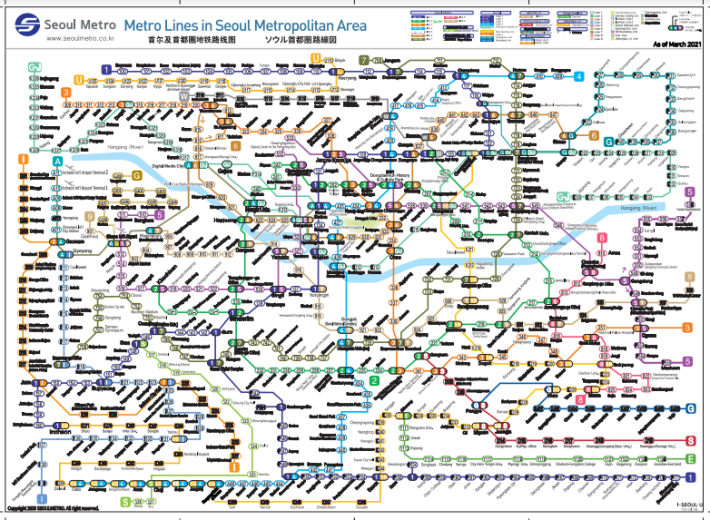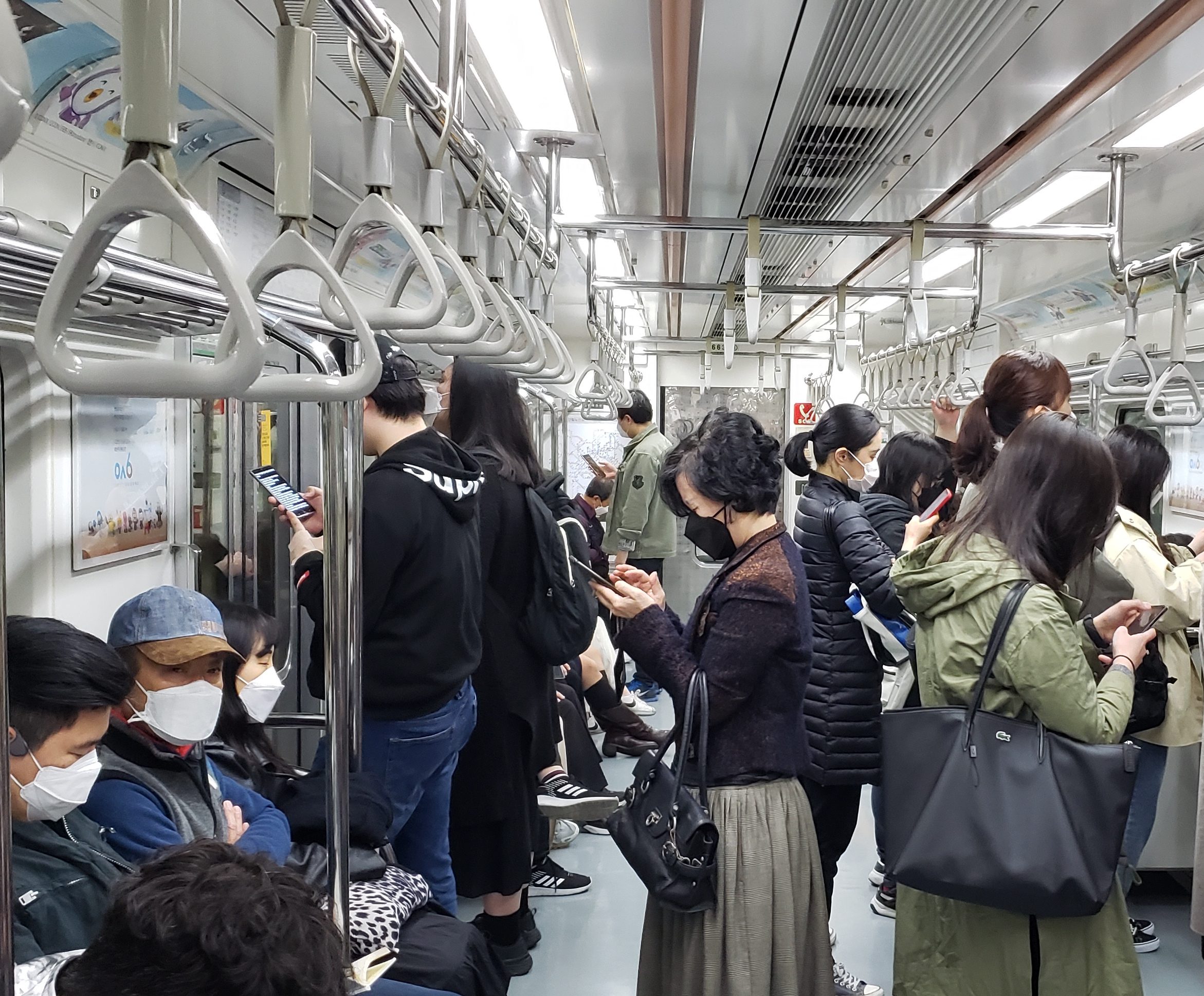Many senior transportation officials in New York compare today’s subways, buses, and roads to the condition of the city’s transportation system back in the 1980s. They are proud of how much safer, cleaner, more reliable, and better maintained the transportation system is today. But, graffiti-covered subway cars and crumbling bridges should not be the benchmark of comparison.
I have learned so much about New York’s transportation system by living in Seoul this past year. You would think that I would have known all about this topic since I was once the manager of planning at the MTA, and I have written a couple of books about New York’s transportation system. But I have been blown away by the things I have seen in Seoul.
Here are six things that New Yorkers can learn from a trip to South Korea’s capital:
New York does not have bragging rights
Seoul’s subway beats New York in the quality of its service, the number of riders, and the miles it covers. What is most remarkable about the size of Seoul’s subway system is that its first subway opened in 1974. New York had a 70-year head start and I doubt that it will ever catch up to Seoul.
I have become spoiled: I have not experienced a subway delay or a broken escalator since I moved here in February. In New York, I always added extra time to a trip in case of a subway problem, but I need not do so in Seoul.
I like Citi Bike, but the bike-share program in Seoul has about 50 percent more bicycles — and it’s much less expensive. An annual plan costs about $35 and you can ride for two hours at a time. Citi Bike is $179 a year and you only get 45 minutes.
Safe below and above ground
Living in a big city with little crime and litter is really wonderful. My five foot-tall wife never worries about walking around by herself, even in a back alley late at night.
When there is little crime, you only need a $5 bike lock, not two locks made of different materials that deter New York’s clever thieves. Koreans can even lock up their kids’ bicycles at a rack near their local park and not have to schlep them to and from their apartments.
Less crime also means that transit agencies can provide better services because they have more resources and fewer expenses. No one is jamming escalators or jumping turnstiles. With fewer crimes, the MTA would not need to spend a fortune preventing and cleaning up graffiti, or repairing vandalized equipment and scratched windows. Likewise, it would not have to build fortress-like token booths that can withstand arsonists and assailants wielding weapons.
Because the subway turnstiles, gates and stairways in New York’s subway stations were not designed to let hundreds of people quickly exit in an emergency, I do worry what would happen if they had to be evacuated. Judging by the public lockers in the Seoul subway stations, Korean are not that worried about terrorist attacks.
The platform doors at every Seoul station make it virtually impossible to fall into the tracks; they also help keep the stations cooler and quieter. The stations have been quite comfortable this past week even when the temperature aboveground reached 98 degrees.
Navigating can be made much easier
Seoul taught me that a couple of simple measures can make it much easier to get around a big city. Giving numbers to stations is really smart. On the #2 line near my apartment, Station 219 (Samseong) is followed by Station 220 (Seolleung) and Station 221 (Yeoksam).
I like that every station has exit numbers, too. When you are trying to navigate below ground or above ground, a sign that says “Exit 2” is a lot easier to understand than one that says “28 Street & Broadway NW.” The platform doors also have numbers, which is helpful because some subway-navigation apps tell you where to stand so that you will be closest to your exit.
I am sure that pregnant or elderly passengers really appreciate the seats that are set aside for them, especially because riders respect the policies. I know my wife appreciates that Seoul’s subway cars have straps to hold onto that are designed for use by both taller and shorter people (although she doesn’t bother using them because train rides are remarkably smooth as well as quiet).
Subway stations can smell great
I had no idea! Many in Seoul have shops to buy cappuccinos, snacks, and jewelry along with fresh-baked treats such as cream-filled buns and croffles (that’s a cross between a waffle and a croissant). My personal favorite is a fish-shaped pastry with sweet, red beans. One station even has an underground farm where you can buy lettuce and microgreens from a vending machine.
Some spaces don’t have to be icky
I used to think that all subway bathrooms were dangerous and bus terminals were gross. But it does not have to be that way! Seoul’s subway stations all have clean, safe bathrooms. I got confused when I was trying to find Seoul’s largest bus terminal. I thought I was on the ground floor of a fancy department store. It turns out that it serves both purposes.
The bike paths underneath highways also are not terrible. Obviously, they aren’t an ideal place to ride, but when they are designed well it turns out they can be quite pleasant.
I do miss some things about New York — starting with its air quality. (The Koreans blame China for the perpetual haze over Seoul.) I also miss seeing people sitting on their stoops and porches. (Almost everyone lives in apartment buildings.) Every time I look at the Seoul subway map, I appreciate how New York’s subway map clearly shows all stations and lines, and offers a sense of the city’s geography, unlike the crazy complicated map that Koreans use.

You can demand more
New York cannot replicate the successes of Seoul’s transportation system anytime soon because American transportation agencies operate in a completely different environment. Korea’s national government generously funds affordable and reliable transportation across the country because most Koreans take a train or a bus to work. Because fewer than 5 percent of Americans do so, there is less support for public transportation federally. Seoul is able to keep its stations clean and properly maintain its platform doors because the subways have almost no vandalism and riders do not pry open doors as they are closing.
Rather than despairing, New Yorkers should raise their expectations and demand that their elected officials do the same. Elected officials do respond to public pressure, so if enough New Yorkers complain to the City Council members about the price of Citi Bikes, the city will allocate money to subsidize them. Improving New York’s aging subway is possible, even if it happens one small step at a time.
THAT BEING SAID, I miss the diversity of New Yorkers’ faces and accents. After all, there is no place like home.
Philip Mark Plotch (@profplotch), former manager of planning and policy at MTA headquarters, is a U.S. Fulbright Scholar and a visiting professor at Sogang University in Seoul. His most recent book is “Last Subway: The Long Wait for the Next Train in New York City” (Cornell University Press).







